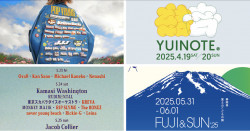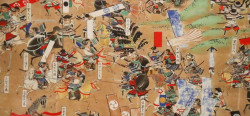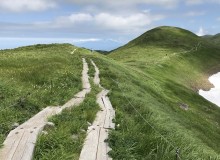
August 5, 2013
Japan From Top To Bottom
Hopping around the nation with our JapanTourist contributors
By Metropolis
Originally published on metropolis.co.jp on August 2013

HOKKAIDO
By R.S. Reynolds
Tancho Crane Reserve in Kushiro
A group of Japanese cranes (tancho) was discovered in the marshlands of Kushiro in 1924, delighting conservationists who believed the species was extinct. Efforts to rehabilitate the population gathered pace, leading to the establishment in 1958 of the Tancho Japanese Crane Reserve. Today, it’s home to 20 cranes, providing both a habitat for propagation and an academic center for study of the species. The reserve guarantees visitors a glimpse of the impressive creatures and the possibility of viewing young hatchlings in the spring.
¥460/110 (adult/child). Open daily 9am-6pm (May-Oct); 9am-4pm (Oct-May). Getting there: 1 hour by bus from Kushiro station (¥1,410).
Hokkaido Museum of Northern Peoples in Abashiri
Celebrate the culture of Hokkaido’s indigenous people, the Ainu, at this rich museum. The focus is not on struggle of the people during and after the settlement—aka colonization—of the island, rather an introduction into aspects of the Ainu way of life. Browse a superb display of colorful clothing, marine transportation, craftwork, carvings, tool development, and hunting and fishing tools, and marvel at the building itself—designed to represent a swan with its wings outstretched. Its glass entrance hall is built to mimic the shape of a traditional Ainu tent.
¥450. Open daily 9:30am-5pm (Jul-Sep). Getting there: 15mins by bus from Abashiri. www.hoppohm.org/english/index.htm
IWATE
By Mifthanzi Ariana Sarashanti
Ryusendo Cave, Iwaizumi
Deep in the eastern base of jagged Mount Ureira, the “cave of the dragon spring” is recognized as one of Japan’s three great limestone caves. Scientists have as yet only explored 3,100m of its estimated 5,000m.
Numerous stalagmites and stalactites have interesting shapes, including a famous one in the shape of Jizo, the guardian deity of travelers and children.
Its most amazing feature, though, is the three subterranean lakes that can be seen on a 30-minute tour, stunningly illuminated by underwater lamps. The third was discovered decades after the first, and its 98m-deep floor can almost be seen through its clear, vivid blue water.
¥1,000. Ryusendo is a short car or bus ride from the main street of Iwaizumi. Open daily 8:30am-6pm. 135min bus from Morioka (¥2,590). Tel: 0194-22-2566.
IBARAKI
By Elysse Hurtado
The Other Izumo
Shimane Prefecture’s Izumo Shrine is one of the most venerated Shinto sites in the country. But there is another branch complete with its own traditions and innovations close to Tokyo in Kasama, Ibaraki Prefecture. Legend has it Daikoku, the main kami (god) of the Shimane shrine, began constructing Japan in 871 CE along with Ibaraki’s kami, Sukunahiko-na-okami. Thanks to this connection, a place of worship for Daikoku was built in Ibaraki as well.
Daikoku watches over the spirits of those who have passed on, which is why the shrine has a graveyard on its grounds. However, in addition to the usual stone-based graves, Izumo has implemented a new, more ecological approach to the afterlife. Popular in Scandinavia, eco-burial involves the concept of “returning to the earth” via being buried directly in the earth with a tree planted above, so your body’s ashes may nourish a new life. Izumo Shrine is having a tough time keeping up with the demand for this new style of burial. They also offer tombs for pets, or the option of an eco-burial, so furry family members will be safe in the afterlife as well.
Free. Open daily 8am-5pm. Getting there: Joban line from Ueno to Tomobe, then Mito line to Fukuhara. www.izumotaisha.or.jp
GUNMA
By Perri Silverstein
Minakami Canyoning

The outdoor adventure capital of Japan offers thrills like skiing, rafting and paragliding every season. Among the lush green of the Tanigawa Range is the Canyons Lodge headquarters where experienced guides, many Japanese and Kiwi, lead participants to some serious canyoning action.
After suiting up in our Neoprene gear, we took a 10-minute bus to the Fox Canyons, where the rush of the waterfalls in the distance made hearts race in anticipation. The four guides taught us the safety procedures, as well as the various ways of sliding down the waterfalls, including head-first, feet-first—and Superman style. The rocky, slippery canyon takes some getting used to navigating, with a 1m slide making for a good warm-up. The big daddy of the course was a 20m beast of a drop, which we were able to slide down and jump off of multiple times. One guide wielded a waterproof camera to capture all of our spectacular, wonky-faced moments. The experience takes three to four hours.
¥8,000 including equipment, guide, group photo and insurance. Getting there: Takasaki line from Ueno to Minakami (3 hours) or the Joetsu shinkansen from Tokyo/Ueno to Jomo Kogen (70 mins). http://canyons.jp
Tokyo
By Hannah Morse
Kyu-Furukawa Gardens

An oft-overlooked spot in Tokyo is this unique garden in Kami-Nakazato, Kita-ku that combines Western and Eastern styles. The property built on a slope originally belonged to Mutsu Munemitsu, a Meiji-period diplomat. The main building that stands there now was designed in the Taisho period by Josiah Conder, using the classic English aristocratic style, while the Japanese garden was created by Ogawa Jihei. Although the garden is beautiful year-round, try to visit during spring to see cherry blossoms and roses, or at fall to view the brilliant oranges and reds of the Japanese maple.
Entry ¥70-150. 1-27-39 Nishigahara, Kita-ku. Open daily 9am-5pm. Nearest stn: Kami-Nakazato or Komagome.
Hyogo
By Erika Clark
Kobe Science Museum

On Port Island, the Kobe Science Museum has five stories of exhibits plus a planetarium, and is packed with interactive elements permitting fun learning for visitors of all ages. A hang-gliding simulation, optical illusions, a room that throws you off your balance, and demos of experiments are some of the activities on offer. Perhaps the most memorable, however, is the technology room featuring robots with various skills. Some play the keyboard, others draw simple shapes. But the newest robot, Shin-chan, is capable of simple conversation, singing, dancing, and even playing “rock, paper, scissors.” Shin-chan can also draw a picture of you, singing while it works.
Entry ¥300-600, planetarium ¥200-400. Open Mon-Fri 9:30am-4:30pm, Sat-Sun & hols 9:30am-7pm. Nearest stn: Minami-Koen (Kobe). www.kobe-kagakukan.jp/english
Okayama
By Rory Jackson
Ushimado Shinto Shrine

A few hundred meters through dense forest has you climbing up stairs through a tunnel of green. The stairs are a rhythmic ascension that isn’t too hard on the legs, and you’ll find the inevitable little old ladies scurrying up to the top. After the first flight there’s a lookout with decent views over part of the town and the islands. It makes for a nice rest but if you’re looking for a quality vista you’re better off checking out the Olive Gardens on a different hilltop. Keep on walking and you’ll head into another tunnel of trees and more stairs, though it’s only 90 meters to the shrine at this point. There’s something mystical about the walk up the stairs—it has the feel of old Japan elusive in today’s world of tour buses and “Don’t step on the grass!” signs.
The shrine is dedicated to the legendary Empress Jingu—popularly known as the godmother of Japan. The decent-sized complex has plenty of moss and maple trees to give it that authentic Japanese atmosphere. The amiable chief priest, Yoshihiro Okazaki, loves to chat in English if you have questions or just fancy a chat.
Try to make it on August 30 for the annual summer festival. Participants walk through a large grass ring three times, offering up their wishes to the shrine.
Getting there: Car or taxi from Oku station to Ushimado swimming beach, where you’ll find the stairs to the shrine.
HIROSHIMA
By Chantelle Silva
Onomichi Temple Trails
Trails from the mountaintop Senkoji Park meander down to the sea, passing a treasure trove of sights. Forget the iPhone—this maze of paths is far too intricate to appear on any map app. Just follow your instincts and see where you end up. You’ll be amazed at how a bustling city can be just minutes from quaint hillside living. Narrow dirt paths turn into cobbled streets which weave between tightly packed houses and bring you unexpectedly face to face with historic temples. Tiny bars and cafés tucked into the mountainside will have you squinting to check your eyes aren’t playing tricks on you.
Getting there: Sanyo line from Hiroshima to Onomichi. Walk 15 mins to the ropeway (single ride ¥280), to ride up and wander down.
MIYAZAKI
By Michelle Madden

Takachiho Gorge
Hardened lava from the largest active volcano in Japan, Mt. Aso, was eroded by the Gokasegawa River. The result is a beautiful gorge with aquamarine water surrounded by columns of volcanic basalt. Rent a rowboat during daytime hours (¥2,000/30 mins) and row past these high walls, contemplating the geological processes that formed this site of exceptional natural beauty in Kyushu.
Getting there: Two-hour bus from Kumamoto station (¥2,300 one way).
These stories and many many more at: http://japantourist.jp







